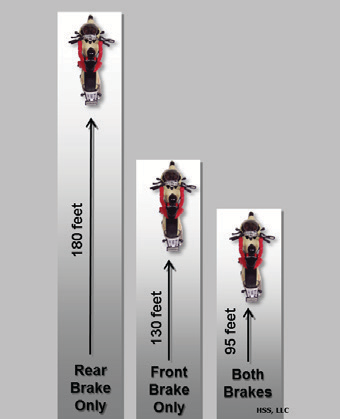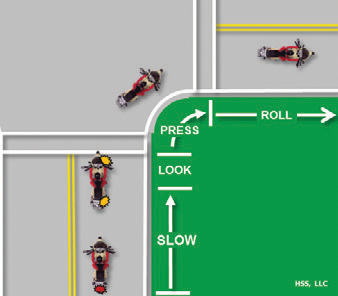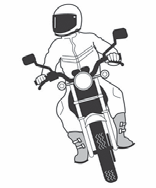
Section 4.4 - 4.5
4.4 – Stopping

Your motorcycle has brakes on the front and rear wheels. Always use both brakes, every time you slow or stop. The front brake can provide 70% or more of your total stopping power, therefore, use of the front brake is required for effective speed reduction. Using both front and rear brakes shortens stopping distance.
To stop your motorcycle, squeeze the front brake and press down on the rear brake gradually until stopped. Grabbing at the front brake or jamming down on the rear can cause the brakes to lock, resulting in control problems.
Normal Stopping in a Curve
If you need to stop while leaned over in a curve, apply smooth gradual pressure to both brakes as you start reducing your lean angle. The more you reduce the lean, the more traction you will have to stop. You can apply more brake pressure as your motorcycle straightens up.
4.5 – Turning
New riders must be aware of the difficulty of negotiating turns and curves. Riders often try to take curves or turns too fast. Reduce speed before entering the turn and maintain this speed. These four steps will help you learn the skills for turning:
- Slow – Reduce your speed before the turn. This can be done by rolling off the throttle as needed and, if necessary, applying both brakes.
- Look – Look through the turn to where you want to go. Turn just your head, not your shoulders, and keep your eyes level with the horizon.
- Press – Press forward on the handgrip in the direction of the turn. Press left handgrip forward– lean left – go left. Press right handgrip forward – lean right – go right. The higher the speed in a turn, the greater the lean angle.
- Roll – Roll on the throttle to maintain steady speed or gradually accelerate through the turn. This will help keep the motorcycle stable.
Steps for Turning

Turning Techniques
Normal Turns

In normal turns, the rider and the motorcycle should lean together at the same angle.
Tight Turns

In slow tight turns, counterbalance by leaning the motorcycle only and keeping your body straight.
Test Your Knowledge
- When stopping, you should:
- Use both brakes.
- Use the front brake only.
- Use the rear brake only.
- When turning, you should:
- Turn your head and shoulders to look through turns.
- Turn just your head, not your shoulders to look through turns.
- Keep your knees away from the gas tank.
Answers
- A – see the section "Stopping"
- B – see the section "Turning"